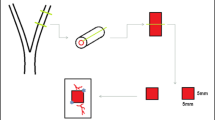Abstract
Objective
To examine the effect of ranibizumab on surgically induced endometriosis in rat models.
Study Design
Endometrial tissue was implanted onto the abdominal peritoneum of 20 rats that were randomized into 2 groups. The rats in group 1 (n = 9) were given 0.6 mg/kg ranibizumab on the 1st and 14th days after the second operation. The rats in group 2 (control group, n = 9) received no medication. All the rats were observed for a total of 28 days.
Results
At the end of the treatment, the mean volume and weight of the explants in group 1 (11.49 ± 6.87 mm3 and 36.61 ± 17.84 mg) were significantly lower than that of the control group (190.6 ± 177.4 mm3 and 187.3 ± 174.5 mg; both Ps < .01). Mean epithelial histologic scores were significantly lower in group 1 (1.11 ± 0.78) than that of the control group (2.33 ± 0.71; P < .01). When compared with the control group, vascular endothelial growth factor (VEGF) immunoreactivities in group 1 showed statistically significant reductions (1.67 ± 0.50; 2.67 ± 0.50; P < .01).
Conclusion
Ranibizumab has significantly regressed the size of the endometriotic implants and caused atrophy of these lesions in rats by decreasing explant levels of VEGF.
Similar content being viewed by others
References
Frackiewicz EJ. Endometriosis: an overview of the disease and its treatment. J Am Pharm Assoc. 2000;40(5):645–657.
Bajaj P, Madsen H, Arendt-Nielsen L. Endometriosis is associated with central sensitization: a psychophysical controlled study. J Pain. 2003;4(7):372–380.
Howard FM. Chronic pelvic pain. Obstet Gynecol. 2003;101(3): 594–611.
Sampson JA. Peritoneal endometriosis due to menstrual dissemination of endometrial tissue into the peritoneal cavity. Am J Obstet Gynecol. 1927;14:422–469.
Gleicher N, El-Roeiy A, Confino E, Friberg J. Is endometriosis an autoimmune disease? Obstet Gynecol. 1987;70(1):115–121.
Machado DE, Abrao MS, Berardo PT, Takiya CM, Nasciutti LE. Vascular density and distribution of vascular endothelial growth factor (VEGF) and its receptor VEGFR-2 (Flk-1) are significantly higher in patients with deeply infiltrating endometriosis affecting the rectum. Fertil Steril. 2008;90(1):148–155.
Hull ML, Charnock-Jones DS, Chan CL, et al. Antiangiogenic agents are effective inhibitors of endometriosis. J Clin Endocrinol Metab. 2003;88(6):2889–2899.
Nap AW, Griffioen AW, Dunselman GA, et al. Antiangiogenesis therapy for endometriosis. J Clin Endocrinol Metab. 2004;89(3): 1089–1095.
Donnez J, Smoes P, Gillerot S, Casanas-Roux F, Nisolle M. Vascular endothelial growth factor (VEGF) in endometriosis. Hum Reprod. 1998;13(6):1686–1690.
Kenneth TE, Kertes PJ. Ranibizumab in neovascular age-related macular degeneration. Clin Interv Aging. 2006;1(4):451–466.
Vernon MW, Wilson EA. Studies on the surgical induction of endometriosis in the rat. Fertil Steril. 1985;44(5):684–694.
Uygur D, Aytan H, Zergeroğlu S, Batioğlu S. Leflunomide-an immunomodulator induces regression of endometrial explant in a rat model of endometriosis. J Soc Gynecol Investi. 2006; 13(5):378–383.
Lebovic DI, Kir M, Casey CL. Peroxisome proliferator–activated receptor-gamma induces regression of endometrial explants in a rat model of endometriosis. Fertil Steril. 2004;82(suppl 3): 1008–1013.
Yilmaz B, Sucak A, Kilic S, et al. Metformin regresses endometriotic implants in rats by improving implant levels of superoxide dismutase, vascular endothelial growth factor, tissue inhibitor of metalloproteinase-2, and matrix metalloproteinase-9. Am J Obstet Gynecol. 2010;202(4):368.e1–368.e1.
Mota A, Carneiro A, Breda J, et al. Combination of intravitreal ranibizumab and laser photocoagulation for aggressive posterior retinopathy of prematurity. Case Rep Ophthalmol. 2012;3(1): 136–141.
Keenan JA, Williams-Boyce PK, Massey PJ, Chen TT, Caudle MR, Bukovsky A. Regression of endometrial explants in a rat model of endometriosis treated with the immune modulators loxoribine and levamisole. Fertil Steril. 1999;72(1):135–141.
Vercellini P, Crosignani PG, Somigliana E, Berlanda N, Barbara G, Fedele L. Medical treatment for rectovaginal endometriosis: what is the evidence? Hum Reprod. 2009;24(10):2504–2514.
Ferrero S, Remorgida V, Venturini PL. Current pharmacotherapy for endometriosis. Expert Opin Pharmacother. 2010;11(7): 1123–1134.
Hughes E, Brown J, Collins JJ, Farquhar C, Fedorkow DM, Vandekerckhove P. Ovulation suppression for endometriosis. Cochrane Database Syst Rev. 2007;(3):CD000155.
Groothuis PG, Nap AW, Winterhager E, Grummer R. Vascular development in endometriosis. Angiogenesis. 2005;8(2):147–156.
Goss PE, Strasser-Weippl K. Prevention strategies with aromatase inhibitors. Clin Cancer Res. 2004;10(1 pt 2):372–379.
Collette T, Bellehumeur C, Kats, et al. Evidence for an increased release of proteolytic activity by the eutopic endometrial tissue in women with endometriosis and for involvement of matrix metalloproteinase-9. Hum Reprod. 2004;19(6):1257–1264.
Ge YL, Zhang X, Zhang JY, Hou L, Tian RH. The mechanisms on apoptosis by inhibiting VEGF expression in human breast cancer cells. Int Immunopharmacol. 2009;9(4):389–395.
Carneiro A, Falcao M, Pirraco A, Milheiro-Oliveira P, Falcao-Reis F, Soares R. Comparative effects of bevacizumab, ranibizumab and pegaptanib at intravitreal dose range on endothelial cells. Exp Eye Res. 2009;88(3):522–527.
Wang Y, Fei D, Vanderlaan M, Song A. Biological activity of bevacizumab, a humanized anti-VEGF antibody in vitro. Angiogenesis. 2004;7(4):335–345.
Ricci AG, Olivares CN, Bilotas MA, Meresman GF, Barañao RI. Effect of vascular endothelial growth factor inhibition on endometrial implant development in a murine model of endometriosis. Reprod Sci. 2011;18(7):614–622.
Cho HJ, Baek JS, Lee DW, Kim CG, Kim JW. Short-term effectiveness of intravitreal bevacizumab vs. ranibizumab injections for patients with polypoidal choroidal vasculopathy. Korean J Ophthalmol. 2012;26(3):157–162.
Krzystolik MG, Afshari MA, Adamis AP, et al. Prevention of experimental choroidal neovascularization with intravitreal anti-vascular endothelial growth factor antibody fragment. Arch Ophthalmol. 2002;120(3):338–346.
Author information
Authors and Affiliations
Corresponding author
Rights and permissions
About this article
Cite this article
Sevket, O., Sevket, A., Buyukpinarbasili, N. et al. The Effects of Ranibizumab on Surgically Induced Endometriosis in a Rat Model: A Preliminary Study. Reprod. Sci. 20, 1224–1229 (2013). https://doi.org/10.1177/1933719113483012
Published:
Issue Date:
DOI: https://doi.org/10.1177/1933719113483012




